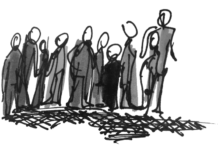by Harleen Kaur Dhillon
Rita Davies recognizes the inequality between men and women in arts. “This is not a new issue. However, there is a renewed interest in the subject at times, as part of larger discussions about equity,” Chair of the Ontario Arts Council (OAC) said.
In mid-October, the OAC released a report on the status of women in arts in Ontario in an attempt to summarize the findings of current research, identify gaps, and provide a knowledge base for future research.
The report was led by Dr. Amanda Cole, who holds a PhD of Comparative Public Policy from McMaster University and is a lecturer in the Masters of Arts and Cultural Management in the Faculty of Business and Law program at Deakin University in Australia.
She is also an Affiliate Researcher with the Centre for People, Organisation and Work (CPOW) at RMIT University in Australia.
The report found that, although the arts industry is gender-balanced overall, females still receive less public visibility, recognition, and income compared to their male counterparts.
This is despite their equivalent levels of education.
More women are present in organizational leadership roles in visual arts, publishing and theatre, and in the top-tiers of Canadian orchestras.
There are also more women in artistic leadership roles in visual arts and publishing, fields which are female-dominated.
Women are underrepresented in media arts/screen, theatre, and music.
The music industry is largely male-dominated in terms of executive and organizational leadership roles.
Many gaps were identified in the current research – the intersection of gender with other factors like, race, age, sexual orientation, and more are understudied.
Other gender identities are largely ignored in research.
Peter Caldwell, OAC Director and CEO, is hopeful that more inclusive research will be added to the collective knowledge database in the future.
“OAC’s report will complement other upcoming initiatives that will add to our collective knowledge in this area,” Caldwell, said. “We look forward to exploring with our arts and funder colleagues how to help the arts community gather better data on their workforce.”
The gaps identified in this report are subject to renewed interest from researchers, and Davies foresees increased research in wider demographics of the population.
“I am pleased that the Ontario Arts Council is able to contribute to our overall understanding of the status of women in the arts. […] We will build on this work by asking individual applicants a broader range of demographic questions, including gender, beginning in 2019-20, through a voluntary self-identification approach,” Davies said.
































